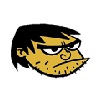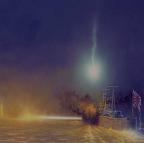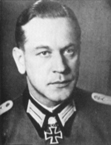littleike
Posts: 159
Joined: 10/3/2007
Status: offline

|
Years ago i was collecting various threads fragments about search arcs.
I post them under here.
If they confuse your ideas disregard please.
Search Arcs Questions
If I set an arc from say, 10-170 degrees, does it search the smaller "slice", or the larger? What about if I set 0-180, does it search the east or the west?
Along the lines of mark24's question, if the search arc is left blank (0,0) does it search 360 degrees?
0-0 means 360 degrees
0-180 means east and south. is the right half of a circle. So from N to S clockwise.
270-360 means from W to N clockwise.
90-270 means east and west means from E to W again clockwise
I've been setting my "scan everywhere" settings for "10 to 0", assuming that all but a thin slice of the arc (the remaining 350 degrees) gets scanned, but that's just an assumption on my part. Although section 7.1 of the manual (p. 151 of the .pdf) alludes to this, it does not conclusively state this.
You are correct in that. Setting goes always clockwise. If you set search from 45 (well, you cannot, but 40 is close enough) to 180, your planes will fly search within arc from NE to S.
If you set search 180 to 45 (again 45 is something that you cannot set, but easier to describe), search arc is from S to NE. Clockwise.
If you set your search arc 0 to 0 you search all 360 degrees but with PENALTIES.
If you set your search arc smaller than 360 degrees then each individual plane will only search a 10 degree arc in each phase - morning and afternoon.
So If I have 6 planes searching... and i want to search 0 to 180.... I can't....as I can't cover everything unless I set the unit to search 360.
However IF I do set the unit to search the arc 0 to 180 this is what happens:
In the morning -
Plane 1 searches 0-10
Plane 2 searches 10-20
etc etc
Plane 6 searchs 50-60.
Then in the afternoon -
Plane 1 searches 60-70
Plane 2 searches 70-80
etc etc
Plane 6 searches 110-120
So with six planes from a unit searching I can search 120 degrees in a given day but only 60 degrees in each phase....or I can have the planes search 360 degrees with penalties.
IF you have more planes than arcs - each arc is given one plane, then the first arc is given two, and the second two etc...until all of the planes have been assigned. This only applies to searches of greater than 4 hexes.
The search arc is always from the first number to the second number. 270-90 would search from pointing straight left to straight right. The first search plane would be sent out at 270, the second at 280, etc.
So when I give the same arc to two catalina groups in the same base I'm doing a stupid search ! They cover the same sub-arc simultaneously... I gain a double check but in one direction at a time, not two checks in two different directions. The best seems to cut in two half-arc and allocate one to each group in order to increase the chances of spotting something more quickly. Right ?
Depends on how you set it up. Let's say you want to search from 180 - 360 degrees (to the west). If both Catalina groups have 9 aircraft, then you would want to assign one group to search 180-260 degrees and the second to search 270-360 degrees. In this way, EACH ARC IS SEARCHED EACH PHASE. So you get your double search bonus plus your bombers would be able to launch an attack in the PM phase if in range.
If you set both groups to search 180-360 degrees, then both groups will search the 180-270 degree sector in the AM phase and the 270-360 sector in the PM phase. The down side is that you would only be able to launch PM attacks against those TFs spotted in the AM phase. The TFs spotted in the PM phase will be safe.
Has anybody come up with a formula or spreadsheet that says for x number of search planes, covering an arc this many degrees, at this range, what would be the probability of searching every hex?
Search in this game is considerably more complicated than just dividing the number of square miles to be searched by the number of aircraft assigned to search. I doubt that anyone has a spreadsheet or formula, since too many other things factor into the result (weather, experience, prior detection level, force composition, altitude, fatigue, leadership, luck, etc.) What you'll find is that the longer you play, the better feel you'll get for what is adequate in terms of search and what isn't (and even this will change depending on your resources at any point in the game.) Granted, this isn't as comforting as being able to rely on a guaranteed formula, but it does make the game a lot more interesting.
Thanks for your reply.
I wasn't looking for a search success formula. I just was trying to gauge what was physically possible, not worrying about the other factors affecting the probability of finding anything. Most would agree that if a player were to assign a 360 degree arc with a range of 15 to two aircraft, chances are these aircraft would not be able to cover the entire search zone in a day. A way to quantify that judgement is what I was fishing for. If I have 5 aircraft, how big an area could I reasonably search? How about 10 or 12? These are the questions I was looking to see if somebody analysed.
I understand what you're asking, but I apparently didn't do a very good job of explaining why there is no definitive answer.
What are you searching for? If it's a 100 ship amphibious invasion force, your two plane group will find it almost every time. If it's a sub, your two plane group will probably never find it. In-between cases run the gamut.
-What is the weather like in both the base hex and the potential target hex? Bad weather in either, you're probably out of luck. Clear weather in both, completely different result.
-What is the experience level of your search group, and what's the experience level of their leader? A group of 12 green pilots with a mediocre/poor leader could fail to find something that an experienced group of 2 planes with a good leader might find most of the time.
-How fatigued is your search group? Doesn't matter how experienced or well led your search group is if they are too tired to take off in the first place...
These are only a few examples of why you can't quantify this very easily - the list goes on. Are you playing Japan or the Allies? Is it early war or late war? Do your search planes have radar on not? Has the TF you're looking for been spotted recently or not? Along with all of these variables and more, you'll end up with at least one or two rolls of the dice before determining a result...
Again, I understand what you're asking, but unfortunately there is no really good generic answer.
Naval Search does not operate like that in game.
Each assigned plane searches a 10 degree arc. Period.
Whether it flys both AM and PM phases depends on distance set and cruise speed of plane.
whether it actually spots anything depends on distance set and pilot quality.
Isn't this true only if you manually set search arcs?
If you don't manually set search arcs then even a squadron with only 3 planes such as many of the Dutch floatplane squadrons will still search an entire 360 degree area.
I see this routinely time and time again where a single Dutch FP squadron of 3 planes finds enemy TFs over areas amounting to far greater than 30 degrees.
I know this isn't a result of having a half dozen or more of these 3 plane squadrons overlapping because I typically use only two of the plethora of Dutch FP squadrons for naval search, placing one near Batavia and one near Koepang.
All other Dutch FP squadrons are used as troop ferries to get the Dutch LCUs where I want them for concentrated defenses in chosen locations.
These two squadrons of 3 planes routinely find IJN TFs across far greater arcs than 30 degrees each.
I do not manually set search arcs because I firmly believe doing so actually handicaps the search ability.
If you do not manually set search arcs, meaning you leave them (sort of) with no settings just the way they are when you first set the group to search, the group will do an 'old style' search using the code that present before search arcs were introduced to the game. That means that each TF will have a % chance of being seen, that % decreasing as the range increases. Also the number of planes and other things are taken into account.
By setting a search arc you have a better chance of seeing TF within the search arc. I presume a much better chance. So if you have limited planes/groups available and just need some general searching, using the old settings can be useful. In most situations, meaning where it makes sense to search heavily in a certain direction, setting search arcs makes sense.
You are almost certainly experiencing, with your 3 plane Dutch units, the code subset routine for naval searching up to 4 hexes. Within 4 hexes you get blanket area coverage although once again the more aircraft you have the better quality it is.
Search arcs is therefore really a consideration for >4 hex coverage, and for practical considerations most players will need a 6-8 hex early warning zone as a minimum. Bear in mind that as the range gets bigger the efficiency of the search diminishes to the point that searching out beyond 12 hexes becomes quite inefficient.
OK, I get it that the answer always depends on "it depends", as conditions always cause a variance. So for those of us who aren't math or science majors, just so I can get a "ballpark feel", let's say I have 3 squadrons of PBY's on an island. Clear weather , pilots with experience in the 70's, good morale ,supply ,support, and they just had a USO show come through. If they are set at 50% search (no vectors) and at 6000', can I assume that I have a good chance of spotting , oh say 12 ships with a CV or two amongst them, out to say 15 hex’s? If not , what numbers ,training and resources would I have to expend to achieve say 75% change of catching the KB before it pastes me?
Three PBY squadrons, at 50% search assignment, means 18 search planes.
1. If the enemy TF is positioned at 4 hexes distance (or less), you have almost a guaranteed chance of spotting it. Mind you if it contains a CV, enemy air patrols/strikes will probably announce their presence soon enough.
2. At 15 hexes distance, by sheer weight of plane search numbers involved, you have a reasonable chance of spotting the enemy. It would be an inefficient use of your search assets but in war, sometimes the better action is not the most efficient.
3. With that many available search planes you would be better off setting search arcs to ensure that at least all vectors are searched out. Becomes particularly useful when a search plane is shot down and the vector gap shows up. Not setting the vectors means you are dependent on the AI choosing the vectors for you. Setting up the vectors yourself also has the benefit that you determine where daylight searching begins. That may be a benefit.
Thanks. I can understand that sectors are more efficient , but I rather like the idea of an near impenetrable wall of circles, from island to island, crossing the central Pacific, and having a pretty good chance of tracking anything passing in range (including a sub or two). Between the search planes, a line of picket subs, and the odd picket of patrol craft , I think it can form a very strong early warning line. It's reassuring that it most likely will work. Basically in this case , I'm looking for reliability over efficiency. But if you feel sector is better, I'll go with it. I'm assuming you feel that the previous "bugs" with using sector are now gone?
I never set a search sector for planes operating off a ship. Kingfishers et al have a small range anyway and it falls within the 4 hex sub routine.
Search vectors therefore are only an issue for land based squadrons equipped with long range planes such as PBY. Yes I do think the earlier problem with using vectors has been addressed.
Basing 3 PBY squadrons at a single airfield is quite a concentration of your limited PBY assets. If the airfield is an island all by itself, say Wake, I can see the attractiveness of having 360 degree coverage. However if it is an overlapping island, 360 coverage may be overkill, particularly if you can avail yourself of the 4 hex blanket coverage using land based Kingfishers to supplement your PBY.
Ultimately it depends on whether the approach route is limited. For most overlapping islands in an island chain, there is a "rear area" which should be reasonably secure from enemy activity. In those circumstances, with limited air search assets, I would plump for setting vectors. It should be very rare to have to regularly reset those search vectors.
Naval search
Have some of my bombers on naval search:
What do the green areas mean when compared to the blue?
What does that arced line mean, intersecting the green area?
Blue and green are morning and afternoon search phases. You can also see all black with is the designated search area covered in both phases. It all depends on how many planes you have patrolling.
The light blue is ASW and that is why the sector is cut in half.
ASW search is half the distance of naval search.
The color of the the arc will change to black indicating that it is being searched in both phases, asw will turn white if it is being searched both morning/afternoon.
I know that when clicking the left mouse button to set the first part of the search arcs, it will show the maximum extent of the search arcs by that unit. Let's say that I only want to search half of that area, and want to search it in both morning and afternoon. Will the search arcs always be split in half, morning and afternoon, even if I have severely condensed the search arcs?
That's my suspicion, which would be disappointing, but I would also assume that it would mean having more planes in the arcs and therefore greater detection capabilities. Correct?
each plane assigned to search will fly a 10-degree arc in both the AM & PM phases. if a 12-plane sqn is set to 50% search, 6 planes will fly in both AM & PM, 60 degrees each phase, you can cover a 120-degree arc, half AM & half PM.
change the 50% to 100% and you can search that entire 120-degree arc in both phases. or keep the %age at 50% and reduce the arc to 60 degrees to cover that arc fully. use the 'show arcs' button on the sqn screen to observe your changes, also the Z hotkey will display all your current search arcs. black arcs (NavS) or white arcs (ASW) indicate coverage for both phases.
Random means it will go out 360 degrees, but based upon the number of planes you have it will take some number of days to complete the arc. has uses, particularly on ships for ASW.
Unless it has been changed in the latest patch, search planes out on a random setting do not daily adjust their search area to eventually cover (over a period of time) all 360 degrees. A random setting starts off at 0 degrees and subject to having sufficient aircraft assigned proceeds in clock direction. If only sufficient planes have been assigned to cover 90 degrees, then that was the only coverage area (0-90 degrees) one ever had searched.
Related questions:
1. Is a search more likely to catch something from searches from land or from those on Carriers, all else being equal?
No difference
2. What are the best search air units?
The ones with pilots that have the highest Nav Search skill, and the unit can be assigned to Nav search.
3. (a bit unrelated)Explain the logistics of an air-group, say, on a Supply Troops mission that then sets Patrol levels at ASW 20%. Does this mean that 80% of the aircraft will supply troops while the rest will look for submarines, essentially meaning the air-group has two missions? Which would then mean that if an air-group chooses the Naval Attack mission, and then is able to select a second mission (say, Port Attack) and then also sets ASW Patrols at 20%, that that group will have three missions? In other words, what the hell are the logistics of setting Patrol levels and what do they mean relative to the primary missions set?
Think about it.... If you assign a unit to Nav Attack and assign a value of 20 to Nav Search and 20 to ASW....what do you think that means?
A unit assigned to Naval Attack will perform a Naval Attack. A unit assigned to Supply Transport. If you assign a % of the unit to perform some other mission then that % will perform that mission.
Real World example- p256 "Fortress against the sun" - "For 3 consecutive days beginning Sept 16, 1942 a single B-17 from the 26th BS dropped bombs on Gizo harbor on Gizo island, ...while other planes flew daily reconnaissance flights." (presumably Nav Search)
In game - the 26th BS is assigned the mission of Port Attack, with a value of 80 or 90 assigned to Nav Search. So 80% of the unit performs Nav Search while 1-2 planes bomb a harbor.
IMO there's a big difference between a) not specifying a search-arc & b) using the 'random arcs' button.
if you tag the 'random arcs' button, then the 'show arcs' button, you'll see that the squadron has been set to a specific arc starting from 000.
i believe (hope) that if you leave the arcs unassigned, you'll get a random distribution of planes shooting out. but someone 'll have to set up a little test-scenario to check that out.
If you assign a unit to Naval Attack you can also assign a secondary mission.
These settings are independent of the percentages you can set at the bottom for search, ASW, train, rest etc.
The set percentages will do those missions, however in the case of Naval Attack if the unit does not find a target to attack IIRC it will default to the secondary mission in the pm phase.
But if the unit does perform a naval attack it will NOT perform the secondary, which again are independent of the percents at the bottom. This should all be addressed in the rule book.
For the sake of clarity, let's say that I have 10 aircraft ready to go. In the above example I have Airfield Attack selected. Under Patrol I have 50% on ASW and 50% on Search, equaling 100%.
With 10 aircraft, 5 will have ASW as a mission and 5 will do Search.
What happens to the Airfield Attack? Since there are no aircraft left and all are on other missions, then it seems to me that none of the aircraft will actually perform an Airfield Attack mission.
Following this logic, if I set ASW to 30% and Search to 30%, four aircraft (40%) would then have Airfield Attack as its mission.
This was my question all along. Are the missions and Patrol levels all taken as one, with equal weight?
If you set 50% ASW, 50% Search..there are no planes to fly attack missions.
From michaelm's posts, I remember that all hexes within 4 hex range are searched anyway (abstracting normal traffic from and to AF spotting enemies). Search arc increases chance to spot enemy inside arc. If you don't set arc, there is percentage change of spotting enemy within range set.
Logic - It's an amazing thing. Its not tricky.
From you above screen shot...If you were to select Naval Attack as your Primary Mission, you would then be given the opportunity to select a Secondary Mission of say Ground Attack.
Then if you set ASW to 30 and Search to 30...you would have 4 aircraft available for your Primary Mission of Naval Attack / Secondary Mission of Ground Attack.
When you execute the turn your unit will fly 3 planes on ASW in the a.m., and 3 planes on Search in the a.m., and if there is an available target (determined by dice rolls/detection etc) it will fly 4 planes in a Naval Attack in the a.m.. If there is not a target available for the Naval Attack in the a.m. then in the p.m. if there is still no available Naval Attack target, it will fly the 4 planes in a Ground Attack because that is the chosen secondary mission, assuming there is an available target for Ground Attack.
In the pm the 6 planes flying ASW & Search will continue flying those missions.
IIRC in the original WitP players did not have the option to assign the % to ASW/Search etc.
note also on AlanBernardo's screenshot, this Mitchell sqn has dangerous low morale of 57. if morale continues to decrease, the sqn won't fly all its planes.
this squadron needs some TLC pronto!
a) switch some planes to Training, to improve morale,
b) grab a better leader, the current leader is awful,
c) add 4 additioal pilots, preferably trained pilots from reserve.
Don’t know what this sqn's history is - fatigue is low, so maybe it hasn't been running continuous ops - but it's borderline incompetent to run its assigned missions, and will get worse rapid if changes aren't made.
Next time just RTFM ...pages 150-154.
|
 Printable Version
Printable Version























 New Messages
New Messages No New Messages
No New Messages Hot Topic w/ New Messages
Hot Topic w/ New Messages Hot Topic w/o New Messages
Hot Topic w/o New Messages Locked w/ New Messages
Locked w/ New Messages Locked w/o New Messages
Locked w/o New Messages Post New Thread
Post New Thread